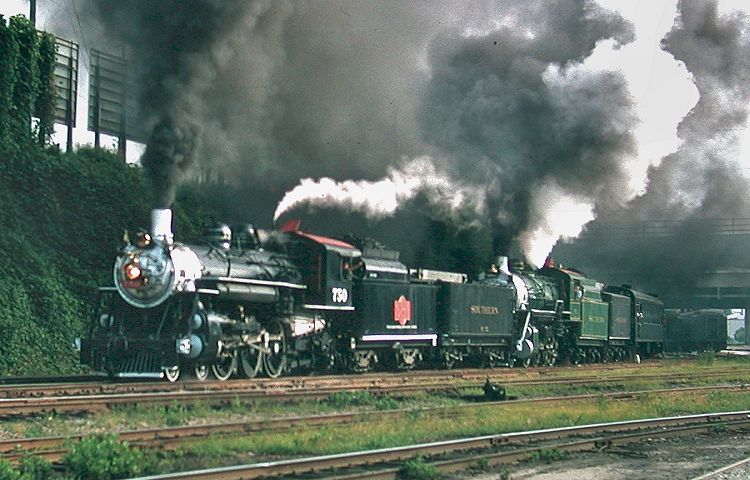In this August 1971 transparency by David V. Leonard, Savannah & Atlanta 4-6-2 No. 750 teams up with Southern Railway 2-8-0 No. 630 for a railfan special at Atlanta. American Locomotive Company built the Pacific in 1910 for the Florida East Coast, where it was numbered 80. In the bankrupt FEC's great locomotive sale (see the page for St. Louis Southwestern No. 677) this 4-6-2 went to the Georgia short line. After retirement from the S&A, No. 750 was donated for preservation. She operated during the earlier years of the Southern's steam excursion program and last saw service with the New Georgia Railroad excursions during the 1980s. The light Pacifics in No. 80/750's class developed 31,000 pounds of tractive effort. They had 69-inch drivers and 22x26-inch cylinders, and carried 200 p.s.i. of boiler pressure. With 2110 square feet of evaporative heating surface and 440 square feet of superheating surface, they had a grate area measuring 47 square feet and weighed about 180,000 pounds. Today this locomotive is displayed at the Southeastern Railway Museum in Duluth, Georgia.
The trailing locomotive, Southern No. 630, was part of a large group of class Ks 2-8-0s delivered by several builders between 1903 and 1910. Retired from the Southern in 1952, she was sold to the East Tennessee & Western North Carolina Railroad and renumbered 207. Fifteen years later the Consolidation was traded back to the Southern for use in its steam excursion program, but in 1983 she was leased to the Tennessee Valley Railway Museum which operated her until 1989. A decade later SR successor Norfolk Southern donated the locomotive to the museum, which restored her to operation in 2011. Dimensions given for the Ks class include 57-inch drivers, 22½x30-inch cylinders, and 215 p.s.i. of boiler pressure. They had 2325 square feet of evaporative heating surface with 525 square feet of superheating surface. Their grate area totaled 54 square feet, and they exerted a tractive effort of 48,693 pounds.
